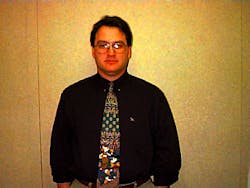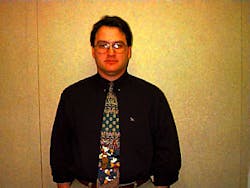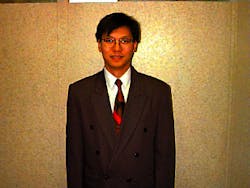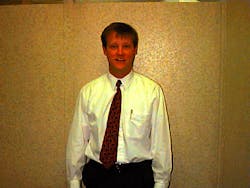Scheduling, Maintenance Software Helps Reduce Pipeline Costs, Downtime
Art Smith, Filbert Law, Rob Sillner
TransCanada PipeLines Ltd.
Calgary
- Transcanada Compressor Facilities: 1997 (Fig. 1) [169,011 bytes]
- This main screen for SAM displays all projects that match the search criteria for the user. Double-clicking on an individual project will provide detailed information and an additional screen for staff assignment for a given project (Fig. 2 [39,661 bytes]).
- The Aero management system tracks information about Aero assemblies including flow characteristics and configurations. The system also helps engineers assign the best assemblies to each compressor based on expected flow characteristics (Fig. 3 [40,999 bytes]).
- TransCanada Pipelines Ltd. in recent years has been engaged in an aggressive construction program (shown here) and has tried to expedite transportation with its new scheduling and maintenance software. (Photograph courtesy of TransCanada PipeLines Services, Calgary) [43,233 bytes]
- Increased compression needs along TransCanada's system have led to installation of more stations. (Photograph courtesy of TransCanada Pipe- Lines Services, Calgary.)[31,142 bytes]
- The Calgary control center monitors all segments of TransCanada's system. (Photograph courtesy of TransCanada PipeLines Services, Calgary.)[20,645 bytes]
The applications enable TCPL better to manage both maintenance scheduling and resources required to keep pipelines running smoothly.
The applications are part of an information systems initiative called Information Technology Next Generation (ITNG). The impetus behind ITNG was the deregulation of the pipeline industry in 1995.
Incentives
In March of that year, TCPL signed an Incentive Regulation agreement with TransCanada shippers that for the first time allowed it to earn, through operational efficiencies, incremental revenue above its long-standing guaranteed return of 11%.For every $1 saved, TCPL and its customers would earn an average of $0.50 each.
Deregulation and the Incentive Regulation agreement provided TCPL with incentives to streamline operations, reduce downtime, and increase throughput, but they also posed new challenges.
TCPL had expanded its facilities by approximately $750 million/year over the previous 5 years. Staffing increases in these areas, however, rose to only 1,080 in June 1998, compared with 988 at yearend 1993.
To improve efficiency, the company focused its initial ITNG efforts on three areas: maintenance scheduling, gas nominations, and compression-wheel assembly.
Before the ITNG initiative, company field personnel from TCPL's five regions were using disparate methods to track compressor downtime and pipeline service requests. Some used paper and fax, while others used off-the-shelf software applications which were too generic to address operational needs adequately.
These programs lacked the specific functionality TCPL needed to manage maintenance scheduling effectively.
Most importantly, the lack of a single maintenance solution across Trans Canada's vast territory (Fig. 1) made it impossible for the company centrally to manage maintenance scheduling for greater efficiency. In addition, separate software programs tracked maintenance resources and materials, resulting in more work for users.
Company officials determined that automation of these functions was the key. A single solution that would break TCPL's time zone and geographic barriers was essential.
This, however, posed another challenge. TCPL's information systems organization was accustomed to devoting 12-18 months on software development. Company managers were now looking for new applications in 6 weeks.
As a result, the ITNG initiative was launched in February 1996.
Objectives; design
The team's first objective was to select a common development platform for all software applications. This would allow developers to learn the same software tool and use the same programs, resulting in a shorter learning curve and faster development.The ITNG team was also looking for a tool that would allow reuse of development code for maximum efficiency. By reusing code from one application to another, developers could get a head start on new programs and deliver software faster.
Another goal was to enable quick and easy installment of its new software applications to meet management's goal of speedy results. After an extensive evaluation of 20 different application-development environments over 9 months, the ITNG team selected the Fort? Application Environment from Fort? Software, Oakland, Calif. A development environment that helps organizations build and automate business solutions, Fort? provided the single development platform the team sought.
The ITNG team also chose Paradigm Plus, an object-oriented analysis and design tool from Platinum Technologies Inc., Oakbrook Terrace, Ill., and EVO Fusion, an application from Hewlett-Packard, Palo Alto, Calif.
Using the new set of development tools, programmers planned to develop a group of software applications: scheduling and maintenance (SAM), event notification for gas nominations, and the Aero management system for compressor-wheel assemblies.
Development project teams were formed to work on each application area.
Because the developers had no experience with the new tools, the team began by spending a month learning Fort?, Fusion, and Paradigm Plus.
Then they met with TCPL business users, including maintenance planners, gas coordinators, and facility supervisors to learn their needs and determine project requirements.
Scheduling, maintenance
With the intense growth of TCPL's main line operations came a corresponding increase in downtime projects.From 1996 to 1997, the number of downtime projects almost doubled-to 1,850 from less than 1,000. The company found it difficult to manage scheduling and maintenance with existing methods, which included a FileMaker database and Microsoft Project software.
Because these tools were deemed too inflexible and unresponsive to handle the rapid growth of downtime projects, TCPL officials were concerned about unplanned, extended downtime, which could cost the company $40,000-100,000/day in lost revenue.
The company determined that it needed a single solution which could integrate and coordinate material management, project scheduling, and technician assignment for greater effectiveness and cost reduction.
Such a solution would ensure, for example, that a technician was available to complete a minor maintenance assignment as scheduled. Without it, the assignment might have to be rescheduled, adding to the cost and potentially diverting needed resources from other projects.
In April of 1996, the development team began working on the new application as a pilot project to evaluate the ITNG initiative. The scheduling and maintenance (SAM; Fig. 2) tool was completed in 2 months and delivered to users in all five TCPL regions.
Today, SAM oversees more than 160 jet engines that move natural gas through TransCanada's 8,980 miles of pipeline and manages $2.5 million in projects. By coordinating project scheduling with technician assignments, SAM helps to minimize downtime.
Because SAM users are spread out among more than 50 remote TCPL offices, ITNG developers built Internet access into the application for use from anywhere in the world using Fort?. This allows occasional users to browse SAM data from any TCPL location via the corporate intranet.
SAM users like the application because it provides a clear understanding of jet-engine maintenance requirements and enables them to allocate resources accordingly.
For example, SAM notifies engineers when a particular unit is scheduled for maintenance so they can make sure adjacent units are not taken down. This keeps units running, thereby reducing jet-engine maintenance and repair costs.
SAM also decreases downtime by scheduling all related maintenance for each unit at one time.
The application also includes functions that help users perform their daily tasks. For example, SAM provides quick reports for users who want a snapshot of the maintenance schedule. For the first time, the application combines resources and maintenance in one system.
SAM obtains data from the TCPL human resources data base, which automatically tells users which maintenance workers are available. For this reason, SAM users soon began using SAM to schedule nondowntime maintenance projects as well.
Nominations
When ITNG was formed, TCPL was receiving 15% of its gas nominations via electronic data interchange (EDI) and 85% via paper fax. The company's goal was to reach 100% EDI by January 1999.Although the paper fax system was time-consuming and required typing nominations manually into the computer system, it had some advantages: Managers could track the nomination sequence for the pipeline based on how many faxes were received. With the EDI nominations, however, there was no way to track the sequence.
The nominations managers within TCPL voiced their concerns to ITNG. In response, four ITNG members in April 1996, including a project leader, an architect, and two engineers, started working on the project, which they called "Event Notification."
The ITNG team built a pilot version of Event Notification in May-June 1996. The final version was completed within 6 months. Since implementing Event Notification, TCPL is receiving 50% of its nominations through EDI.
The Event Notification system monitors the software applications that keep track of EDI nominations. This translates into the monitoring of thousands of transactions every 24 hr. Event Notification also monitors those systems that maintain the gas-shipping schedule together with tracking costs and billing.
Based on flagged events, Event Notification lets managers know when there is a problem with pipeline operations. Managers register for checks and events, then receive e-mail or pager messages immediately when an event, such as a process failure, has occurred.
This enables the gas accounting and nominations staffs to fix problems swiftly and keep the nominations process flowing.
The Event Notification system was recently put to the test. On the July 4, 1998, long weekend, TCPL received a very large EDI nomination from a customer. Because of computer congestion, the nomination was rejected by TCPL.
Within 15 min of the failure, the Event Notification system alerted both the business and information technology (IT) staff. They managed to address the problem and accept the nomination before the customer found that the nomination had not been received.
Compressor wheel assemblies
The rapid expansion of Trans Canada's facilities, combined with a reduction in the size of the operations analysis group from 12 to 7 people, made it increasingly difficult for TCPL to ensure optimized compression throughout its pipeline network.In November 1996, when the ITNG team began looking into an automated solution, all configuration information for TCPL's more than 400 centrifugal compressor assembly wheels was managed by a couple of key employees using a combination of manual and computerized methods.
A large binder contained all the flow patterns. The master schedule, which listed wheel placement for the next year, was stored in an Excel spreadsheet file. The parts list, configuration diagrams, manufacturing diagrams, and overhaul kits were stored as files on a departmental file server in the Calgary office.
Clearly, there was a need to consolidate the wheel information into a single system so that other TCPL operations personnel could access it. By giving all personnel better access to this essential information, the company hoped to improve decision making, ensure optimized compression, and earn incremental revenue.
The ITNG team's answer was to build a software application called the "Aero Management System" (Fig. 3). It records information that mathematically describes the flow characteristics of the more than 400 compressor-assembly wheels. The wheels are rotated through production compression sites to maximize pipeline efficiency.
Aero brings configuration information together for the first time. The system maintains an inventory of each wheel, its distinct parts, its installation location, and how each wheel flows under specific conditions.
Based on this information, engineers select the correct wheels for each compressor location, taking into account expected transportation volumes and ambient conditions.
By building an interface to other TCPL systems, developers have enabled TCPL engineers to share wheel-configuration information. Soon, an Internet document-management subsystem will allow users in the field to obtain all documents related to each assembly, ensuring that they have the required parts.
With Aero, TCPL now has a single, up-to-the-minute source for assembly-wheel information. Aero was designed and built over 8 months by three developers who used the project as a way to learn Fort?, EVO Fusion, and Paradigm development tools.
The team employed the Fusion methodology, which enables an incremental development or "time-boxing" approach. They broke the project into five feature sets, soliciting input from users on features and the order in which they should be developed.
After completing each time-box, the Aero team put it into production and received feedback from users to double-check the progress of development.
The Aero system provides several benefits. It tracks TCPL, Great Lake Gas Transmission, and NOVA Aero assemblies for the first time. In addition, it has the potential to minimize the purchase of new wheel assemblies.
Since the company now tracks the wheel-assembly flow configurations of its GLGT and NOVA affiliates, it can borrow, swap, and share assemblies, instead of spending $500,000 for a new wheel. This helps TCPL compete by keeping its costs, and therefore its rates, down.
ITNG results
To date, TCPL has completed 14 applications with its new development tools and is working on 28 more. ITNG applications currently support 325 users; plans are to bring the entire company on-line eventually using the same user interface on Web browsers, PCs, and Macintosh computers.By selecting a standard development environment, TCPL gained several benefits:
- Developer training time has been reduced to 1 month from 3 months because a single platform replaces multiple technologies.
- The entire application set is easier to maintain, more reliable, and more cost-effective.
- The same developers can support both small and large software applications, which results in greater flexibility, higher efficiency and lower costs.
- TCPL's development platform insulates its software applications from the hardware platforms on which they run. This results in "push button" installations that are essential for short projects and for delivering software once a month. It also makes software upgrades easier.
- Parts of applications are re-used during the construction of new applications.
The merger has also created a 36,000-km transmission system that delivers natural gas across Canada, from British Columbia to Quebec. Peak deliveries on the NOVA Gas Transmission and TCPL Canadian Mainline systems alone, not including affiliates associated with both firms before formation of the partnership, now equal more than 22 bcf.
The Authors
Art Smith is project manager for Information Technology Next Generation initiative at TransCanada and responsible for the customer information systems group in TransCanada's energy transmission business.
Smith has more than 10 years' experience developing and implementing over 20 distributed systems in real-time and management information processing environments and holds a BS in electronic information systems engineering.
Filbert Law is the project leader for TransCanada's schedule and maintenance team and responsible for delivering business solutions to the business partners in the field. Law has more than 9 years' system development experience in a distributed client/server environment and holds BS in computer science and a bachelor of commerce in management.
Rob Sillner was the project manager for the Aero assembly management project. He has more than 10 years' experience building custom information systems for a variety of business functions and is currently responsible for the engineering simulation systems team at TransCanada. Sillner holds a bachelor of commerce in management information systems.
Copyright 1998 Oil & Gas Journal. All Rights Reserved.



